
Over the years, I’ve noticed that emerging artists’ number one problem is marketing their music to gain new fans and grow a loyal fanbase. It’s the most common question that I see in my inbox.
In our current climate, the key to getting yourself in front of potential fans cost-effectively is through short-form video content. Typically, musicians associate this type of short-form content with the dance, lip-sync and crazy challenge videos found on TikTok. The good news is that it doesn’t have to be any of that. This trend of short-form videos can actually be quite simple and more in line with what’s natural for musicians, which is “live” performance.
Short-form live performance videos have grown in popularity in the past couple of years and have shown to be effective for marketing new music and even helping some artists go viral.
In this blog, I cover all the basics you need to know about how to go about creating short-form videos as a musician to promote your music on social media.
The Transition From Long To Short-Form Video
With the rise of the internet, smartphones and social media over the past 20 years, we have now officially come to the end of the traditional music video era and the new reign for short-form videos. This transition has been going on for many years, starting with Musical.ly (before becoming TikTok). You can even argue this trend started as early Twitter’s Vine in 2013 with its 6 second looping videos.
With the higher cost of attention in the oversaturation of content in our feeds, the best way to reach fans on social media is through short-form video content. When it comes to marketing yourself and your music, video content is king and this shift to short-form makes it much easier for you. Not only is typically cheaper to produce, you can often do a lot of it yourself.
This has also influenced how music is being made and released, with songs becoming shorter in length (2 minutes or less) and a stronger focus on releasing singles and EPs instead of full albums.
At this point, it should be no surprise that the importance and validity of a traditional budgeted music video for independent artists has diminished. This doesn’t mean you can’t or shouldn’t do a long-form music video at some point, but it’s challenging to get your return on investment if a lot of money goes into it. I see traditional long-form music videos more of a luxury as a brand-building play than a necessity for promoting a song. Some artists want to create long-form music videos as an artist extension of the music for storytelling and there’s nothing wrong with it if you can afford it.
So if you’re still early in your career and you don’t have a budget, your focus should be strategically using short-form video content to build an audience/fan base at scale.
Short-Form Video Basics
Short-form video is essentially any type of video content that is optimized for social media consumption. More specifically, I’m referring to videos of you performing the song similarly to how you would in a traditional music video. Here’s an overview about short-form videos that you need to know.
There are 4 fundamental characteristics that make a short-form video.
Vertical / Portrait Oriented Video – The video orientation naturally fits with how people consume content on their smartphones. It takes up more visual real estate when someone scrolls through their feed, making your video more noticeable. This means you should be filming with your phone upright (portrait) and not turning it to its side (landscape). If you’re shooting on a camera, it’s best to shoot in 4K so you can crop the footage to fit a 9:16 orientation. The orientation of the video does not effect the potential for the video to go viral. However, vertical videos are more immersive and engaging so it gives you a better chance.
Length – The video length is typically less than 1 minute, but what is considered optimal is debatable and will vary by platform. With YouTube shorts, it has to be less than 180 seconds (179 seconds to be safe) or it won’t be recognized as a Short. Whereas with Instagram Reels, it has to be no more than 3 minutes or the algorithm won’t recommend your video to non-followers. For TikTok, you can’t have a song in a video be longer than 60 seconds due to licensing agreements. In general, short-form videos between 15 to 30 seconds will get the most engagement. The length of the video is key because the average person isn’t watching long videos while scrolling on social media.
On Video Captions – If your music has lyrics, there should be text captions on the video itself, usually in a color like yellow so it stands out more. Sometimes the text will have a black or white outline to help it stand out and not blend too much into the video. Having the lyrics on the video itself is important because many people scroll their news feed without the sound turned on. Seeing text changing in the video also catches people’s attention. Having lyrics is not necessary as some artists prefer a clean aesthetic, but it may vary by song or video. It’s at least worth testing with or without lyrics to see what may perform better with your audience.
Optimized For Short Attention – We all know that attention spans continue to diminish in the digital age, so the video content needs to jump right into the action. This means no slow or long intros. Generally, you need to hook viewers within the first few seconds. This can entail starting with the hook or chorus of a song. Some may even add a visual element in the video editing to draw attention, like camera shake, starting upside down or in black and white.
As an artist, there are 3 general ways you can approach short-form video for potentially reaching new fans.
- Directly music related: This entails things like performing original music or covers, sharing, playing beats, producing music, mixing mashups live, DJ sets, etc.
- Making music content tying in interests / hobbies / passions: This is incorporating music and other interests like dance, sports, food, pets, drugs or fitness. For example, making songs based on food recipes like how Good Boy Noah has done with his puppet cheetah.
- Brand or personality focused: This is more about showcasing your personality whether it’s from doing meme content, reaction videos or short skits, but not music. This can naturally overlap into your interests and hobbies if it’s a part of your brand.
What I’ll be covering is content that is more specific to musicians and involves music performance. Regardless of which way you want to approach it, the intent for your short-form video should seek to either:
- Entertain
- Inspire / Motivate
- Educate
If you’re able to accomplish those things, you’re more likely to have your videos shared and engaged with.
As for where short-form video content is shared, the 3 platforms you’ll want to post on are:
- TikTok
- YouTube Shorts
- Reels (Instagram and Facebook)
Each platform has their differences so you’ll need to make sure you optimize your short-form videos to fit the platform you’re posting on.
Short-Form Video Setups & Examples
Here are some basic short-form video setups / ideas to consider starting with. Most of the examples shared below are from hip hop / rap artists because that’s what I normally listen to and come across but it can still be applied to other genres and styles. It’s up to you if you want to do an actual live performance or just a lip sync. Lip sync is much easier to film while performing the song live in a video can require more work to capture good audio, but it comes off as more authentic.
Please Note: All setups discussed below involve a performer in the videos. Technically, you can execute short form videos without you physically in it and just have the lyrics go with your music over stock footage. The problem is this isn’t going to be effective for most, especially if you’re not an established artist yet.
My theory on why short-form performance clips are impactful is because we’re more likely to connect and engage with the music when we see another human performing the song. So if you have any hesitancy being on camera, you may want to learn to be comfortable with the uncomfortable. After all, creating these short-form videos is also great practice for actual live performances if your goal is to make a living off music.
However, if creating video content on social media really isn’t for you or you don’t plan on doing live performances, then you may want to consider other music marketing options.
1. Performing with still camera on a tripod
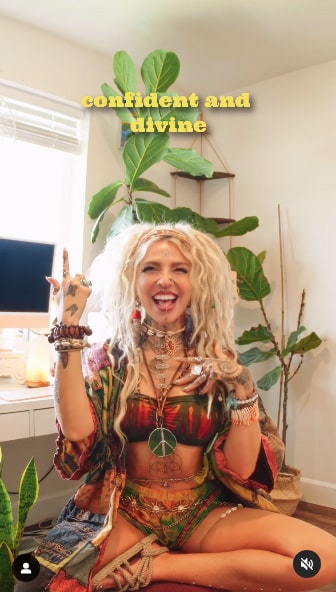
This is the simplest thing you can do. Set up your smartphone or camera on a tripod and record yourself. This can be easily done in your home, the backyard or at a local park. Because the shot is still, you’ll want to make it interesting with the background, what you’re wearing or any props in the video.
Once you get comfortable, think about other visually appealing or interesting places. This can be done in national parks with beautiful landscapes, popular vacation spots, tourist attractions (in front of the Eiffel Tower) or busy public areas with tons of people behind you. Just be aware that some places have strict rules about filming so be careful and be discrete.
Examples
- LaRussell in front of a house
- Tanner Adell at a barn
- Stevie Ray at his doorstep
- Mei Semones playing the guitar at her doorstep
- Shanin Blake in a living room
- Shanin Blake on a log in nature
- Infinity Song (Band) in front of an old structure
- Amp Live (Producer) in his studio
- Amp Live on a beach
- Samara Cyn sitting on a chair on a green hill
- Samara Cyn sitting on steps in front of green wall
- KODUKU singing in an open field
- Mary Ann Alexander singing at home with short intro
- Alam Khan playing the Sarode at home (Instrument Only)
2. Using actual live show performance

If you’re already doing a live performance (hopefully in front of a decent sized crowd), you can have someone record you on stage performing full songs. This can also be staged and done in a larger backyard area and a crowd of people. You can then extract the best segments and add lyric captions on top.
LaRussell is someone I’ve come across who has done this a lot. Here are my favorite examples of his:
3. Performing the song in one static location
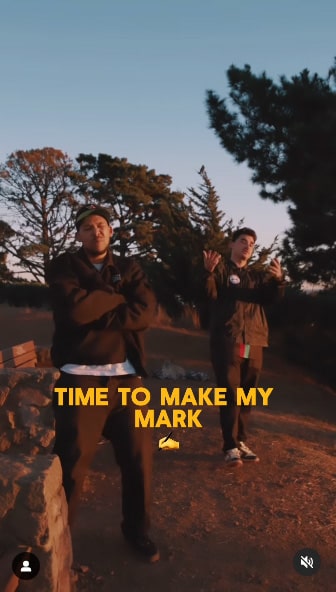
For this setup, you’ll need someone to film you. The idea is you’re performing in one area, but the camera will be moving with and around you to make things more interesting.
LaRussell is someone who does a great job of this as a majority of the short form videos he puts out uses this basic setup.
Examples:
- A-1 and his producer in a park
- LaRussell performing on the street
- Pink Sweat$ performing live in a parking garage
- Russ in Paris with the Eiffel Tower behind him
- THRONE in a room
- RMS on a street
- Alexia Evellyn in front of a waterfall
- Miles Minnick rapping in an alley street
- Norman Sann rapping in a parking lot
4. Performing the song with constant movement
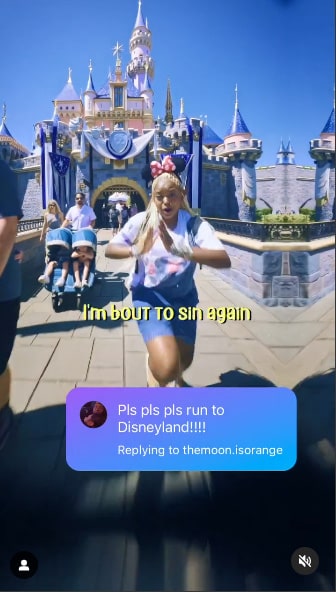
Instead of standing in one area, you as the performer can be constantly in movement. It can be as simple as walking straight towards the camera or moving around within a scene.
The rap duo Flyana Boss has done a great job of executing this with running in their videos, which has prompted many viewers about how they were able to pull it off as smoothly as they have.
Examples:
- Shanin Blake slow walk towards camera
- Pink Sweat$ on a moving boat
- Flyana Boss running out of a restaurant
- Flyana Boss running in Disneyland
5. Performing a song while doing another activity
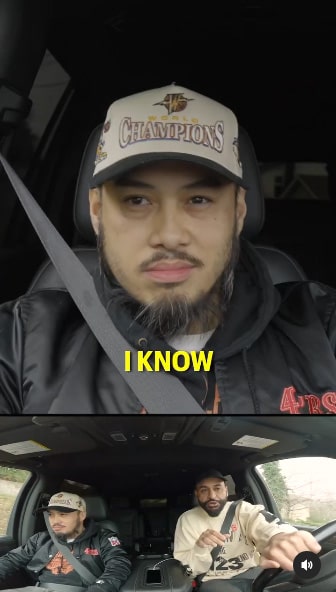
Another setup to change things up is to perform while doing another activity. This can be done with a static camera or someone else to film you.
The activity can depend on your personality and interests that make sense with your brand or the song you’re performing. Or it can just be completely random or unexpected to create some intrigue.
Rapper Locksmith created a video series called Lock Lyft where he invites fans on a car ride and he performs for them while driving.
Examples/Ideas:
- Driving (Locksmith)
- Biking (Flyana Boss)
- Cooking
- Rolling up a joint
- Exercise
- Hiking
- Roller Skating / Skateboarding
- Household chores
6. Performing with props or extras
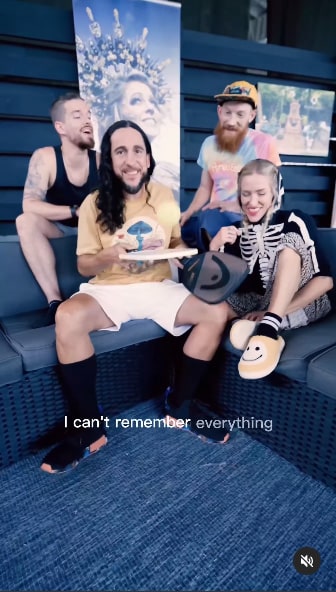
Incorporating props or other extras into your setup is an easy way to make your videos more interesting. This can be something as simple as a big hat, a mask, green screen, other performers or even the rain. You can also try using your pet or your kids.
The band Walk Off The Earth and LaRussell does a really good job of using props in their videos.
Examples
- Static performance with kid
- Juggling a ball with paddles
- LaRussell with a photographer in front
- LaRussell shot through a basketball hoop
- LaRusell with bikers
- Coyote staging a set in a kitchen with props and actors
- Pertinence in front of a car and hanging mic
- Scoochie Boochie in front of volcano using greenscreen
7. Performing and acting out the lyrics
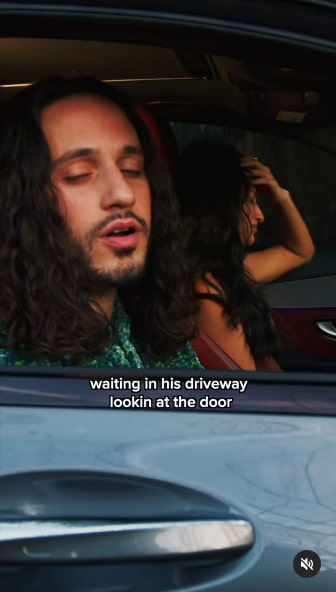
Lastly, consider creating a scene and acting out the lyrics you’re performing as if it was a one shot music video. Let’s say you’re performing a song about a break up, have someone in the shot pretending to be your partner and reacting to the news. Here’s an example of that from Russ (TikTok) and another on Instagram for the same song.
Short-Form Video Creation Tips
– Do multiple full takes. When filming, rather than just doing a verse and hook in one take, do multiple takes of the entire song so you can extract the best parts as different videos. You can do this to test which parts of the songs perform better.
– Maximize each location. One location can be used to do multiple songs and in different parts of the space. For example, let’s say you film in a park. You can shoot standing on a table, sitting on a bench, in front of the playground, on a swing or slide, on a basketball court, etc.
– Schedule a day for content. If possible, dedicate a day for content (“content day”) where you can record multiple videos in one session to save time. Performing 3 songs in 3 different locations in a day can potentially yield up to 18 to 36 short videos for you to post.
– Stay organized. Create a system to keep all the video files organized because you’ll be posting these videos multiple times. If done right, you should have an organized library to pull from to be consistent with your posting.
– Perform versions of songs already on socials. If you do a lip sync, just make sure to do it to a version currently available on social platforms, like TikTok and Instagram, so that you can add your song from within the app itself. This allows you to earn royalties from your video and it displays your artist and song name in your post. When you upload your music to an aggregator like DistroKid, they will have an option to distribute to social platforms. In most cases, a platform like Instagram can auto-detect the song and tag it on the post without you having to manually add and sync the track.
– Practice before filming. Make sure to really practice and rehearse your performances so you’re ready to shoot. Keep going even if you mess up a part. This saves everyone time, especially if you hired someone to film you.
– Don’t put text captions on the bottom. Captions are traditionally on the bottom, but it shouldn’t be with short-form videos. The placement of text captions for your lyrics should be placed closer to the center of the video because of the overlays that TikTok and Instagram has. If you have the text too low, it will overlap with the title, caption and engagement overlays on the bottom. If you have the text too high, it may likely cover your face and you definitely don’t want that.
– Autogenerate captions to save time. You can auto generate captions for your videos in typical video editing software like Adobe Premiere or Final Cut Pro, which is what I use. The same goes with mobile as my preferred app for editing on my phone is InShot and it has the ability to auto generate text captions from the audio. There are also free online video editing tools like CapCut and Veed that offer free plans. Instagram and TikTok also have a feature that can generate captions for you. Regardless of which tool you use, it will require making edits as it won’t be perfect, but it will at least save you some time.
– Keep testing. Don’t assume something doesn’t work the first time you post it. There are a lot of variables involved when you share something to social media, whether it’s the day of the week, time, platform, world events, the song or the video content itself, so you can’t draw conclusions after one post.
– Experiment and get creative. A lot of what was covered in this blog are basic starting points, so there’s definitely room to get creative and experiment. There are other elements, concepts, edits, props or camera tricks that can be incorporated to create a more visually appealing experience. Maybe there’s an opportunity to turn your videos into a series or highlighting a fun alter ego.
Final Thoughts on Short-Form Video
Creating short-form videos to promote your music doesn’t have to be complicated or expensive. As you’ve seen in the examples shared in this blog, it’s actually quite the opposite. Many artists have found success doing simple, straightforward performance videos to promote their songs on social media. If you’re consistent, you should see gradual growth of followers as these platforms will start to suggest your videos to new audiences.
I found viral success posting these types of videos on Instagram and TikTok. Read my full breakdown of this album release campaign that led to multiple videos going viral and Snoop Dogg reposting one of them.
But remember, creating and sharing short-form video content is only one part of marketing. It’s an important tool for attracting new potential fans and engaging your current supporters, but there’s a lot more that goes into the marketing process. I’ve covered many aspects of it on various blogs on this website. Just don’t expect that this is the only thing you need to do to build a music career from scratch.
If you’re just starting out and have a few releases on digital platforms like Spotify and Apple Music, don’t be afraid to throw some ad money behind these videos to get some feedback. If you encounter a situation where one of your videos goes viral organically on a platform, then you definitely want to spend money for ads to add gas to the fire.
Lastly, music quality still matters. Your success with short-form videos is still going to be dependent on how good your songs are. If you do short-form videos consistently for a year or so and still haven’t gained traction, maybe your songs aren’t good enough yet and that’s okay. As long as you like your work, keep learning and improving upon your craft.
Not all songs should be fully marketed with a budget, but sharing these low-cost performance short-form videos is a great way to see what songs are ready.
For more specifics on how to shoot video with your smartphone, check out this blog here:
6-Step Guide to Make Quality Cover Song Videos With Your Smartphone




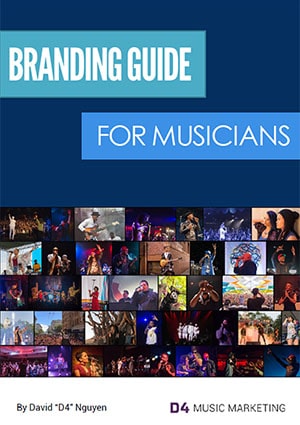

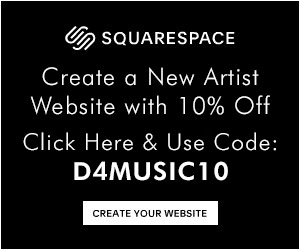

Thank you
Really helpful